Unmanned Aerial Vehicles (UAVs) can be used to provide wireless connectivity to support the existing infrastructure in hot-spots or replace it in cases of destruction. UAV-enabled wireless provides several advantages in network performance due to drone small cells (DSCs) mobility despite the limited onboard energy. However, the problem of resource allocation has added complexity. In this paper, we propose an energy-efficient user clustering mechanism based on Gaussian mixture models (GMM) using a modified Expected-Maximization (EM) algorithm. The algorithm is intended to provide the initial user clustering and drone deployment upon which additional mechanisms can be employed to further enhance the system performance. The proposed algorithm improves the energy efficiency of the system by 25% and link reliability by 18.3% compared to other baseline methods.
翻译:无人驾驶航空飞行器(无人驾驶飞行器)可用于提供无线连接,以支持热点现有基础设施,或在发生破坏时取代现有基础设施。无人驾驶航空飞行器(无人驾驶飞行器)的无线为无人驾驶小型电池(无人驾驶小细胞)的移动提供了网络性能方面的一些优势,尽管机载能源有限。然而,资源分配问题增加了复杂性。在本文件中,我们提议采用经修改的预期-最大化算法,根据高斯混合模型(GMM)建立一个节能用户集群机制。算法旨在提供最初的用户集群和无人驾驶飞机部署,并在此基础上使用更多机制来进一步加强系统性能。提议的算法提高了系统的能源效率25%,与其他基线方法相比,将可靠性18.3%联系起来。




